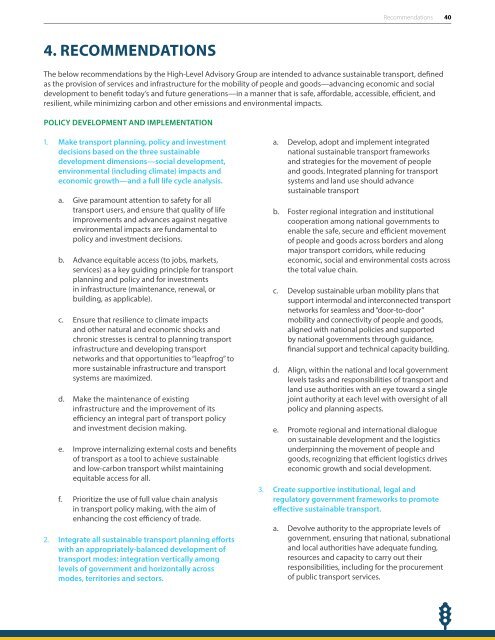MOBILIZING DEVELOPMENT
a5OQ306q56U
a5OQ306q56U
Create successful ePaper yourself
Turn your PDF publications into a flip-book with our unique Google optimized e-Paper software.
Recommendations 40<br />
4. RECOMMENDATIONS<br />
The below recommendations by the High-Level Advisory Group are intended to advance sustainable transport, defined<br />
as the provision of services and infrastructure for the mobility of people and goods—advancing economic and social<br />
development to benefit today’s and future generations—in a manner that is safe, affordable, accessible, efficient, and<br />
resilient, while minimizing carbon and other emissions and environmental impacts.<br />
POLICY <strong>DEVELOPMENT</strong> AND IMPLEMENTATION<br />
1. Make transport planning, policy and investment<br />
decisions based on the three sustainable<br />
development dimensions—social development,<br />
environmental (including climate) impacts and<br />
economic growth—and a full life cycle analysis.<br />
a. Give paramount attention to safety for all<br />
transport users, and ensure that quality of life<br />
improvements and advances against negative<br />
environmental impacts are fundamental to<br />
policy and investment decisions.<br />
b. Advance equitable access (to jobs, markets,<br />
services) as a key guiding principle for transport<br />
planning and policy and for investments<br />
in infrastructure (maintenance, renewal, or<br />
building, as applicable).<br />
c. Ensure that resilience to climate impacts<br />
and other natural and economic shocks and<br />
chronic stresses is central to planning transport<br />
infrastructure and developing transport<br />
networks and that opportunities to “leapfrog” to<br />
more sustainable infrastructure and transport<br />
systems are maximized.<br />
d. Make the maintenance of existing<br />
infrastructure and the improvement of its<br />
efficiency an integral part of transport policy<br />
and investment decision making.<br />
e. Improve internalizing external costs and benefits<br />
of transport as a tool to achieve sustainable<br />
and low-carbon transport whilst maintaining<br />
equitable access for all.<br />
f. Prioritize the use of full value chain analysis<br />
in transport policy making, with the aim of<br />
enhancing the cost efficiency of trade.<br />
2. Integrate all sustainable transport planning efforts<br />
with an appropriately-balanced development of<br />
transport modes: integration vertically among<br />
levels of government and horizontally across<br />
modes, territories and sectors.<br />
a. Develop, adopt and implement integrated<br />
national sustainable transport frameworks<br />
and strategies for the movement of people<br />
and goods. Integrated planning for transport<br />
systems and land use should advance<br />
sustainable transport<br />
b. Foster regional integration and institutional<br />
cooperation among national governments to<br />
enable the safe, secure and efficient movement<br />
of people and goods across borders and along<br />
major transport corridors, while reducing<br />
economic, social and environmental costs across<br />
the total value chain.<br />
c. Develop sustainable urban mobility plans that<br />
support intermodal and interconnected transport<br />
networks for seamless and “door-to-door”<br />
mobility and connectivity of people and goods,<br />
aligned with national policies and supported<br />
by national governments through guidance,<br />
financial support and technical capacity building.<br />
d. Align, within the national and local government<br />
levels tasks and responsibilities of transport and<br />
land use authorities with an eye toward a single<br />
joint authority at each level with oversight of all<br />
policy and planning aspects.<br />
e. Promote regional and international dialogue<br />
on sustainable development and the logistics<br />
underpinning the movement of people and<br />
goods, recognizing that efficient logistics drives<br />
economic growth and social development.<br />
3. Create supportive institutional, legal and<br />
regulatory government frameworks to promote<br />
effective sustainable transport.<br />
a. Devolve authority to the appropriate levels of<br />
government, ensuring that national, subnational<br />
and local authorities have adequate funding,<br />
resources and capacity to carry out their<br />
responsibilities, including for the procurement<br />
of public transport services.


